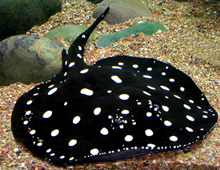Description: Polka-dot stingrays have a black to dark brown, smooth, oval-shaped body with light round to oval spots covering the top half of their body. The underside is light gray to white with no spots. The eyes are raised from the dorsal surface. The robust tail has a venomous spine at its tip capable of inflicting pain.
Size: Adults of this species can measure over 18 inches (46 cm) in diameter. Females are usually larger than males.
Behavior: These bottom dwelling rays bury themselves in the sand during the day and hunt for food at night.
Diet: Their diet consists primarily of fish and aquatic invertebrates, but they also consume freshwater snails and crabs.
Senses: Like other freshwater stingrays, Polka-dot stingrays have keen eyesight. Their protruding eyes allow them to see what is above them, while they are on the river bottom and also help them navigate through their murky environment. They also possess ampullae of Lorenzini (special sensing organs called electroreceptors, forming a network of jelly-filled pores) located on their skin around the nose and mouth that allows them to detect minute electric fields generated by other living organisms. This sensory detection warns them of potential predators and prey.
Reproduction: They are ovoviviparous, meaning females produce eggs that are hatched within the body, so that the young “pups” are born alive without placental attachment; fertilization is internal. Unique among this species is the size of their litters. They average around seven to eight pups per litter; other stingrays average around four.
Habitat/range: Polka-dot stingrays inhabit sand banks and slow-moving tributaries with substrates of mud or sand. They are native to the Xingu River Basin of Brazil.
Status: Listed as Data Deficient on IUCN Red List. Due to their restricted range in South America, there is great concern that mining or other polluting activities could threaten their survival. Under the IBAMA regulations, exports from Brazil are now illegal, although captive bred rays are available.



